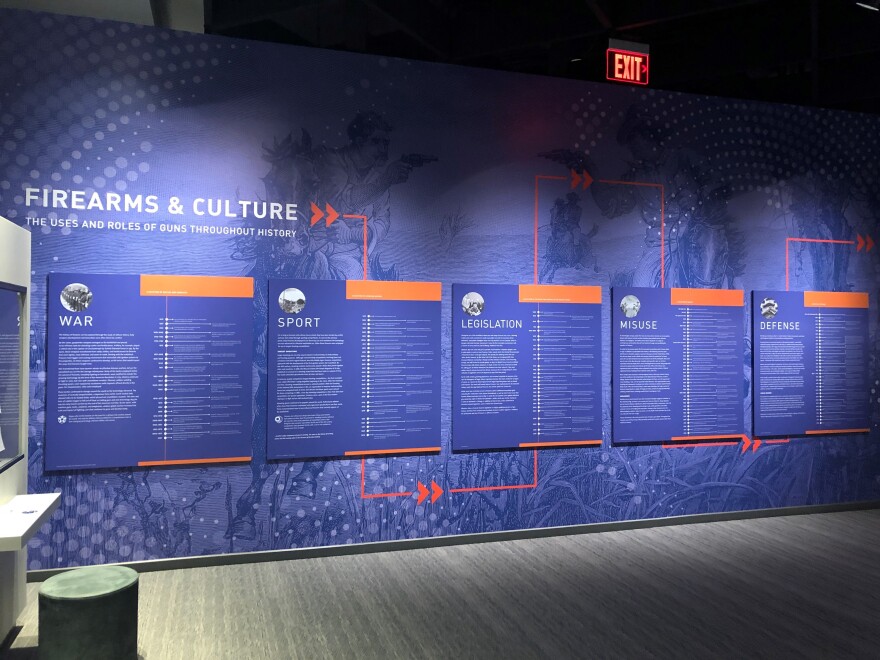Tucked away in the northwest corner of Wyoming is one of the largest gun collections in the world: The Cody Firearms Museum. But it's recently gotten a makeover, moving away away from being a monument to guns and toward being an educational space on gun safety, history and culture.
The museum is located at the Buffalo Bill Center of the West alongside four other museums and near the east entrance to Yellowstone National Park. So often, people just happen upon it. That was the case for Kim Cato and her family, visiting from Idaho.
"We were not planning to go in here," Cato said.
Cato said that's because of her own previous experience with the museum.
"I was here as a child and my dad dragged me through it and it was just rows and rows of guns and it was just not exciting."
But now, the recently renovated museum seemed more intriguing. So Cato and her husband Kevin, their 12-year-old son, Tyson, and 15-year-old daughter, Jillian, took a tour with Ashley Hlebinsky, the curator.
People and technology
"So we're actually going to start right here," said Hlebinsky, as she led the family to the mission statement plastered in big letters on a wall at the entrance of the museum. "A lot of times when you talk about firearms history, you think about the history of technology, but it's also a history of people, and with that history of people it can be good, bad and indifferent."
In an effort to address the good, the bad, and the indifferent, the first gallery is focused on basic firearm safety, especially where kids are involved. There's an interactive table and the first thing you see, "Do you know what to do if they [children] are out in the real world and they encounter a real firearm?"
We had an experience where a child climbed over a fence and handed my son a gun.
Under the question, a set of rules are mounted at a height designed to be read by children. They include: Stop. Don't touch the firearm. Get an adult or a law enforcement officer. Cato found these guidelines really helpful.
"We had an experience where a child climbed over a fence and handed my son a gun," Cato said. "And didn't you try to shoot it?"
"No, I didn't even touch it," replied Tyson.
Cato was surprised because she had heard a different story when it happened a couple of years ago. It turned out some of the details were murky. Nothing bad happened but it was scary for the family.
"Tyson, are you aware of these rules now?" Cato asked.

Tyson replied in affirmative. This is the kind of conversation the museum is trying to foster. Even if visitors walk in with nearly no idea about firearms, the museum's administrators hope that at least they can learn how to handle hard situations that firearms may present.
Next, Hlebinsky took the Catos to the Cost of War exhibit.
"As we're walking into this gallery, really the first thing you encounter is this big graphic," Hlebinsky said. "And some of the images you see when you walk into the gallery are the gravestones at the Arlington Cemetery and children affected by war."
The Catos also learned about Audie Murphy, the World War II veteran and actor who broke a taboo of the time by talking about his experience with what we would now call Post Traumatic Stress Disorder or PTSD. And the family learned that during the Civil War, some arms were produced by enslaved people.
Multiple viewpoints
The renovation tries to address the diverse audiences expected to visit. Hlebinsky said the museum offers different lenses through which people can learn about firearms, such as shooting sports, the technological evolution of firearms, and military history.

Museum leaders say they also don't want to ignore the current conversations around the misuse of firearms, specifically in mass shootings. The Catos ended their tour in front of a big black and white mural, produced by the artist known as JR in partnership with Time Magazine.
Fifteen-year-old Jillian Cato described the mural this way: "It's a big group of people. Many of them have signs. It seems to be a huge debate. One side is anti-gun and the other side is pro-guns rights."
The mural is derived from a video featuring images of Americans on all sides of the debate. Hlebinsky said as a museum curator, she can't tell people what they should think about firearms. But she hopes the information spurs conversations among visitors.
As the Cato family looked at the mural, the father, Kevin said they aren't really gun enthusiasts.
"I'm not into killing things. There's no reason to have a gun unless you're going to try to kill something," he said. "I have really enjoyed this, though, and I'm going to do more research on the history of guns and how they are going to affect warfare."
That's the goal of the new Cody Firearms Museum. Not to win people over as gun enthusiasts, but to help them learn and think about gun culture.
Copyright 2019 Wyoming Public Radio





